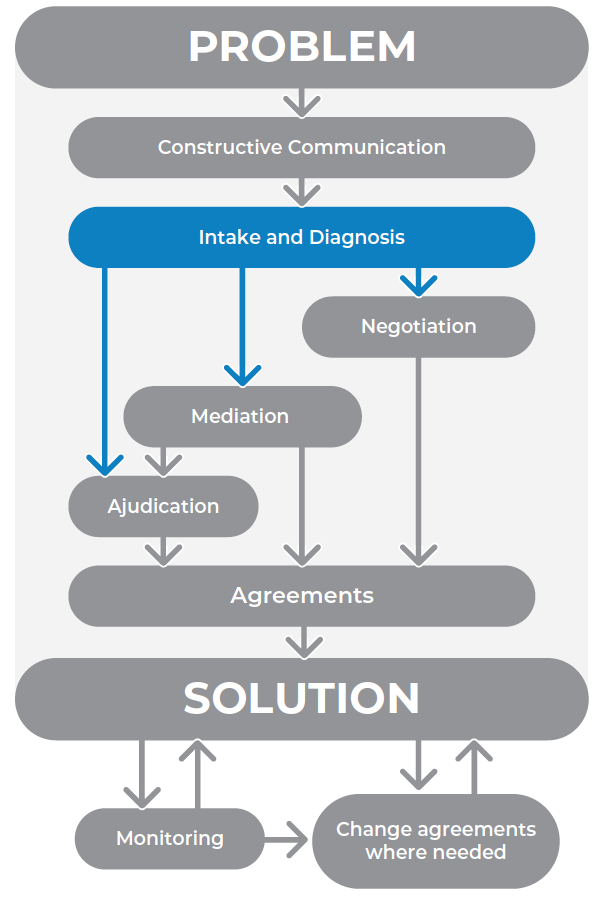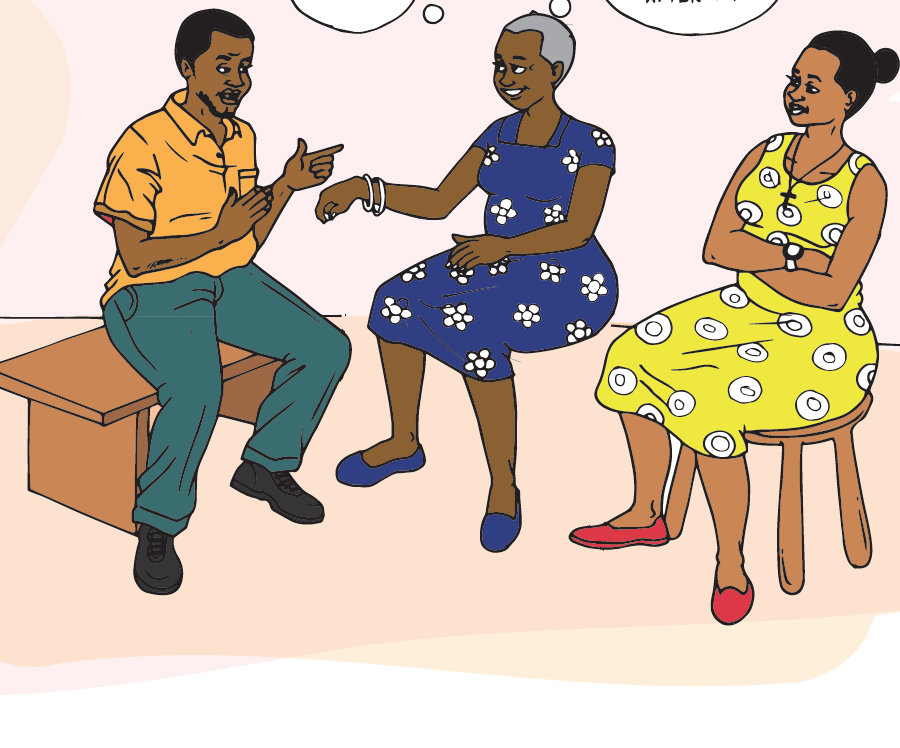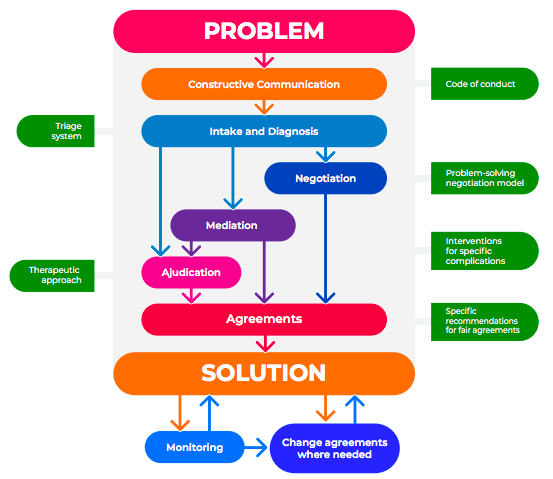Intake and diagnosis
Strongly recommended
Intake
Families should do an intake with a practitioner who will assess the most effective intervention, irrespective of what that practitioner can offer him
Beware !
Intake
Families should not seek help from a practitioner without conducting an intake first
Strongly recommended
Diagnosis
The practitioner should diagnose and advise on the most appropriate intervention based on an intake

The family first conducts an intake with the practitioner to find out what their needs are
Parties cannot always find solutions themselves.
They need help from a third party. In order to reach agreements, the parties start by conducting an intake. Together with the practitioner they find out what their needs are.
The practitioner provides a diagnosis, based on the intake
Based on the intake outcomes, the parties receive a diagnosis from a trained professional. The practitioner prescribes the most appropriate intervention, for example mediation or adjudication.
According to research, the intake and diagnosis are essential for the parties to receive the best help possible.
Amaka galina okusooka okwewandiisa n’omuyambi okuzuula biki bye betaaga
Enjuyi zombi tezisobola kugonjoola nsonga zabwe nga bo.
Betaaga omuntu atali omu ku bbo okubayambako. Okusobola okutuuka ku nzikiriziganya, enjuyi zombi zirina okutandika n’okwewandiisa. Oluvanyuma wamu n’omuyambi bazuule biki byebetaaga.
Omuyambi akola okwekkenenya okusinziira ku kuwandiisa.
Okusinziira ku kuwandiisa, omukuggu agamba enjuyi zombi kiki ekibaletera obutakkanya. Olwo omuyambi abayitiramu mu ngeri y’okutaasa egya okukola obulungi ku nsonga yabwe, okugeza ng’okutabaganya oba okulamula.
Okusinzira ku kunonyereza, okuwandiisa n’okwekkenenya bya mugaso nnyo okusobola okuwa enjuyi obuyambi obusinga obulungi.
Okuwandiisa
5. Amaka galina okwewandiisa n’omuyambi, amale asalewo okutaasa okugya okusinga okukola, sinsonga oba ye anabayamba oba nedda. Ekiba kikolebwa
6. Amaka tegasaba obuyambi okuva eri omuyambi nga tegasoose kwewandiisa. Genderera
Okwekkenenya
7. Omuyambi alina okwekkenenya ensonga era nawa amagezi ku ngeri y’okutaasa en’esinga okuyamba okusinziira ku kuwandiisa. Ekiba kikolebwa
Obujjulizi obukozeseddwa mu kulungamizibwa okw’okutaano (5), okwomukaaga (6) n’okwomusanvu (7) busangibwa ku mukuttu ogwa www.hiil.org/projects/uganda-family-justice-catalogue
What practitioners say
Consistent with literature research:
Keep records. As practitioner, make sure intakes, diagnoses and further steps are recorded. This will make it easier to ensure agreements are respected and evaluated.
Equal participation. As practitioner, let both parties participate actively in the diagnosis. Both sides should get equal attention and be equally involved in the process.
Keep the end in mind. Both parties should create a list of desired outcomes and then work backwards.
Other suggested practices:
Define clearly what the conflict is about. The parties should clearly define what the grievance is about before the intake process.
Enkola ezising’obulungi abayambi mu Uganda ze bagamba
Ziri ku mulamwa n’okunonyereza okuli mu biwandiiko:
- Tereka ebibakwatako. Ng’omuyambi, kkakasa nti okuwandiisa, okwekkenenya buli kimu ekikolebwa kiwandiikibwa. Kino kigya kugonza mu kugoberera n’okulondoola enzirikiziganya.
- Okwenyigiramu okw’ekyenkanyi. Ng’omuyambi, kkiriza enjuyi zombi z’enyigire mu kwekkenenya. Enjuyi zombi zirina okuwebwa obudde obw’ekyenkanyi n’omukisa okwenyigiramu ekyenkanyi.
- Beera ng’olwooza ku nkomerero ya binoKeep the end in mind. Both parties should create a list of desired outcomes and then work backwards.
Enkola endala eziyinza okukolebwa:
- Zzuula ku ntandikwa kiki obutakkanya kwebuva. Enjuyi zirina okunyonnyola kiki ekivaako obutakkanya wali nga bewandiisa.
Resources and Methodology
The role of family courts is shifting from one of only adjudicating cases, to planning and managing them (Lande, p. 432). In particular, there has been a movement towards a single judge and [interdisciplinary] professional team that would deal with all issues affecting a particular family, including separation (Lande, p. 432). [Integrated] family courts that actively manage referrals to various services use two alternative systems: the ‘tiered’ and ‘triage’ system (Lande, p. 432).
A tiered system of solving family disputes starts with the least intrusive and least time consuming service and, if the dispute is not resolved, proceeds to the next available process. The next steps are more intrusive and directive than the preceding one. Typically, parents therefore start mediation before adjudication (Salem, p. 371).
In a triage system, the most appropriate services are identified at the beginning (Salem, p. 372). Parents may complete an initial interview, and agency representatives help them to identify the service they believe will best meet the needs of the family (Salem, p. 380). The process may involve screening, development of a plan for family services, appointment of a case manager, development of a parenting plan and periodic court review (Lande, p. 432).
We compare the triage system with the tiered system.
For people separating, is a triage system more effective than a tiered system for their well-being?
The databases used are: HeinOnline, Westlaw, Wiley Online Library, JSTOR, Taylor & Francis, Peace Palace Library, ResearchGate, Bloomberg Law and LexisNexis Academic.
For this PICO question, keywords used in the search strategy are: mediation, litigation, fairness, process, outcome, agreement, divorce, family.
- Peter Salem, The Emergence of Triage in Family Court Services: The Beginning of the End For Mandatory Mediation (2009)
- John Lande, The Revolution in Family Law Dispute Resolution (2012)
- Nancy Ver Steegh, Family Court Reform and ADR: Shifting Values and Expectations Transform the Divorce Process (2008)
Desirable outcomes
Desirable outcomes Prior to participating in the adversarial litigation process, parents should have the opportunity to participate in mediation, so that they may collaborate with one another and create their own agreement (Salem, p. 274). If mediation does not result in an agreement, other processes remain available (Salem, p. 276).
Some courts in the US have adopted the Differentiated Case management system as a way to more efficiently match families with processes and services. A case goes through triage and a service plan is created for the family. Unlike linear service delivery models [i.e. a tiered system], high-conflict families proceed directly to the programs and services most likely to be successful for them in developing a parenting plan or having parenting arrangements decided for them. Court systems have expanded their role to include activities such as screening, assessment, creation of service plans and referral to community resources (Ver Steegh, p. 668-669). A system that identifies the best match between a family and available service, will provide the most appropriate services, resulting in more efficient use of resources and reducing the burden on families (Salem, p. 381).
Undesirable outcomes
If parents are referred to mediation and do not settle, they are often required to participate in additional, and increasingly intrusive processes [such as adjudication] until matters are resolved. When more services are necessary, more money and time is demanded of the parties. This raises frustration, as expressed by members of a focus group in Wisconsin, United States (Salem, p. 382).
Some argue that triage will result in some disputing parents missing out on mediation and its important benefits.
They say that there is no evidence that one can accurately predict who will succeed in mediation and who won’t, and so suggest that mediation should be mandatory for virtually all parents disputing child custody matters (Salem, p. 372).
Balance of outcomes
In determining whether a triage approach to separation is better than the tiered approach for the well-being of parents and children during a separation process, the desirable and undesirable outcomes of both interventions must be considered. From the above evidence, the benefits of a triage approach outweigh those of a tiered approach. In particular because the triage system limits frustration of the people compared to the tiered system. Unlike the tiered model, the triage system ensures that the parties make use of the most appropriate intervention.
Recommendation
Taking into account the strength of evidence and the clear balance towards the desirable outcomes of a triage model, the following recommendation can be made: For people separating, the triage model is better than the tiered model for their well-being.


